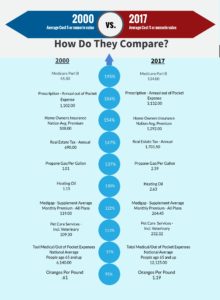(Washington, DC) – Social Security beneficiaries have lost nearly one – third of their buying power since 2000, according to the 2017 Social Security Loss of Buying Power Study by The Senior Citizens League (TSCL). The findings represent a big loss of 7 percent in buying power, from 23% in 2016 to 30% over the past 12 months alone. “This occurred as inflation has begun to climb, but people receiving Social Security received an annual cost – of – living adjustment (COLA) of just 0.3 percent for 2017, ” says TSCL’s Social Security policy analyst and the study’s author, Mary Johnson. Housing and medical costs —particularly for prescription drug expenses — were among the most rapidly – rising spending categories over the past year.
The erosion of buying power in Social Security benefits occurred even for people retired for as little as five years. People who retired in 2012, for example, experienced a similar trend — COLAs increased benefits only 5 percent, but typical retiree costs rose more than twice as fast, by 11.28 percent. “When costs climb more rapidly than benefits, retirees must spend down retirement savings more quickly than expected, and those without savings or other retirement income are either going into debt, or going without,” Johnson says.
The study’s findings illustrate the impact on the buying power of Social Security benefits when the economy goes from a period of extremely low inflation to more typical rates of inflation. Over the period that TSCL has conducted this study, there has been only one other year when the loss in buying power was larger — 8 percent in 2011. During 2011 there was no COLA, but inflation spiked. The following year, in 2012, Social Security benefits increased by 3.6 percent.
In 2016 the COLA was zero and this year retirees received just 0.3 percent, but the 2018 COLA will be nowhere near 3.6 percent,” Johnson says. Based on consumer price index (CPI) data through August of this year, Johnson estimates that the COLA for 2018 will be 1.8 percent.
More than 840 respondents to TSCL’s annual senior survey, conducted from January through March of this year, confirm that monthly household expenses made steep increases over the past year. The majority, 67%, indicated their monthly expenses went up by more than $79. “With today’s Social Security benefit averaging $1,320 per month, that’s an unsustainable level of rising spending when there’s just a 0.3 percent benefit increase to match,” Johnson says.
Social Security beneficiaries receive a small automatic increase in their Social Security checks most years, intended to help their benefits keep up with rising costs. But since 2000, COLAs increased benefits a total of just 43 percent while typical senior expenses have jumped 86 percent.
* Where no average prices are available, numeric values from the U.S. Bureau of Labor Statistics CPI-U are used.
The survey found that a person having the national average Social Security benefit in 2000 — $816 per month — would have $1,169.80 per month by 2016. However, because retiree costs are rising at a substantially faster pace than the COLA, that individual would require a Social Security benefit of $1,517.80 per month in 2017 just to maintain his or her 2000 level of buying power.
The study examined the increase in costs of 39 key items between 2000 and January 2017. The items were chosen because they are typical of the costs that most Social Security recipients must bear. Of the 39 costs analyzed, 26 exceeded the percentage of increase in the COLA over the same period. The selected items represent eight categories, weighted by approximate expenditure. The study used the same weightings that the government uses in calculating the Consumer Price Index for the Elderly. “This study illustrates why Congress should enact legislation to provide a more fair and adequate COLA,” Johnson says. “To put it in perspective, for every $100 worth of expenses seniors could afford in 2000, they can afford just $70 today,” Johnson adds.
A majority of the 57 million senior and disabled Americans who receive Social Security depend on it for at least 50 percent of their total income, and one – third of all beneficiaries rely on it for 90 percent or more of their income. To help protect the buying power of benefits, TSCL supports legislation that would base COLAs on the Consumer Price Index for the Elderly (CPI-E). To learn more, visit www.SeniorsLeague.org.
###
With 1.2 million supporters, The Senior Citizens League is one of the nation’s largest nonpartisan seniors groups. Its mission is to promote and assist members and supporters, to educate and alert senior citizens about their rights and freedoms as U.S. Citizens, and to protect and defend the benefits senior citizens have earned and paid for. The Senior Citizens League is a proud affiliate of The Retired Enlisted Association. Visit www.SeniorsLeague.org for more information.
ALSO AVAILABLE TO JOURNALISTS: Full report including NEW chart of Top Ten Fastest Growing Costs of Older Americans Retired Since 2012. Call 800-333-8725 to request a copy of the report.


